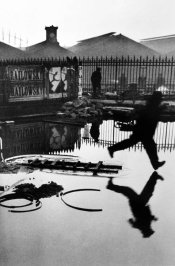The devil is in the details, as they say, but that would still be a strong photograph even if it wasn't "just so". It's also not candid, btw, it was a planned re-enactment of that flag raising, though it was done in the same time-period, at least so I understand. Nonetheless, it is a great photo, and could not have been easy to make.
Anyway, I think the same can be said for most iconic photos, what makes them iconic is their particular collection of details, and for most, if one detail were missing, it wouldn't remove much from the whole.
I also think that what makes an image iconic is not necessarily wholly visual, I'm thinking in particular of Eddie Adam's photo of the Vietnamese prisoner getting executed on the streets of Saigon. Certainly the visual elements are there, but what makes it powerful is
time, I'd say. That is, we're observing this person's very last second of life, and without that element of realization it wouldn't have the power it does (imho).
For reference;
http://anunlikelyweapon.com/index.html






